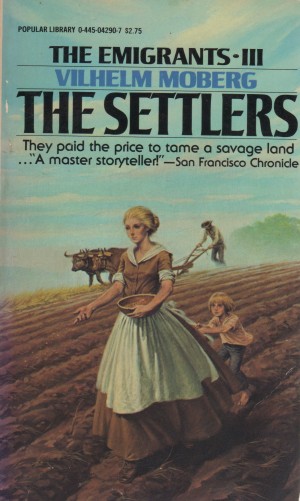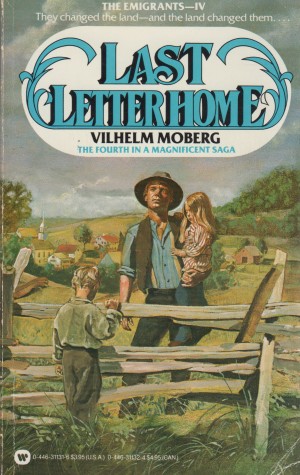 The Settlers by Vilhelm Moberg
The Settlers by Vilhelm Moberg
(1978. Popular Library. ISBN 978-0873513210)
Not as much sex but lots of its aftermath. That’s a glib way of saying that The Settlers, Moberg’s third novel in this four-part series of Swedish immigration to Minnesota is rooted, in many ways, in the story of how Karl Oskar Nilsson and his wife, Kristina, and their five surviving children adjust to a life of desolation, poverty, hardship, and promise on the shores of Chisago Lake in Minnesota Territory’s St. Croix River Valley. Moberg’s emphasis here is on the domestic: on the day-to-day lives of the Nilssons as they carve a family farm from 160 acres of rock, timber, and brush along the lake’s shoreline and, ultimately, move from sod hut to log cabin and finally, into a proper two-story, timber framed farm home that dwarfs any expectations envious onlookers (or Kristina for that matter) believed possible.
Moberg’s writing style is crisp. The dialogue rings true. There are characters, fully developed and not cardboard cutouts, from heroes (Karl Oskar) to the slightly unsavory (Karl’s adventure and fortune seeking younger brother, Robert) that draw you into the story and keep the pages turning. Set during Minnesota’s tumultuous conversion from mere territory to state (1858), a time of intense political intrigue both nationally (the Civil War is only three years distant) and regionally (competing teams of Democratic and Republican territorial legislators are so at odds, they draft competing state constitutions!), Moberg places the struggles of an immigrant family in their proper historical context, a feature of the book much enjoyed by this history/political science major.
Religion, the fundamentalism of the Swedish Lutheran Church placed against the evangelical zeal of apostate Lutherans and other Protestant denominations (featuring my favorite character in the series, Ulrika, the former prostitute turned Baptist preacher’s wife), is explored here not as an afterthought or an adjunct to the main storyline, but as an integral aspect of early immigrant lives. The building of a local school and the first Swedish Lutheran church in the burgeoning community, all hewn from the hardwoods and rapidly dissipating pines of the wilderness being tamed by the industrious Swedes, is a highlight of narrative in the middle section of the book.
Moberg explores the details of Karl and Kristina’s marriage in a very realistic context: the fact that intimacy, at least for fertile women of childbearing age in the 1850s, invariably led to pregnancy and, if the infant survived the trauma of childbirth at home, another mouth to feed in times of hardship. His depiction of the conflict within a married woman’s mind of that era is realistic, detailed, and compelling as we witness Kristina struggle with how to deal with the inevitable aftermath of coupling with Karl. A brilliant scene, wherein Kristina studies her face in a mirror given to her by Ulrika, is a representative example of such introspection:
As a girl, Kristina had often been told that she was beautiful…But where was the girl who so many times blushed at the words, “You are beautiful!” Where now were her full cheeks with the soft little dimples of laughter? What had become of her nicely rounded chin? Where was her blossom-tinted color? Where the young girl’s quick and clear glance? What had become of her lips that were once full as wild strawberries? Every day she met this depressing sight. Was this she? She herself? These gaunt, wrinkled cheeks, this pale-gray color, this sharply etched chin, these tired, fading eyes without a glint, this caved-in mouth with teeth missing—this was herself, what was left of the once beautiful girl Kristina of Duvemala!
To be fair, there is a lengthy section where Robert’s wanderings towards California after his immigration clashes with the Karl/Kristina story, a section that I found to be overly long, sometimes confusing (due to the back and forth nature of the intersecting narratives), and diminished the flow of the novel. But not every aspect of this portion of the tale is troublesome. Robert’s agonizing demise due to tuberculosis is again, well wrought and imagined and the unresolved conflict between Robert’s dreamy wishfulness and Karl’s pragmatic industry adds another layer of complexity and nuance to the narrative.
In the end, Moberg got it mostly right and I am looking forward to reading the concluding book in this four-part saga of Swedes coming to my “neck of the woods”. 4 stars out of 5.

Last Letter Home by Swedish writer, Wilhelm Moberg (1978. Warner Books. ISBN 0446311316) is the final installment in Moberg’s four volume set depicting the emigration of Swedish settlers, the Nilssons (the Nelsons by the end of this concluding story) from Sweden to the St. Croix River Valley in east central Minnesota. The closing novel depicting the rugged, hardscrabble lives of Karl Oskar, his wife Kristina, and their children as they build a succession of homes in the Center City/Chisago Lakes area just across the border from Wisconsin is, to my way of thinking, the least satisfying of the four books. Here’s my take on Last Letter Home.
Moberg continues to explore the intimate, religious, economic, and political interactions of the Nilssons with their immigrant neighbors, chronicling in some depth the simmering desire between the long married patriarch and matriarch of the clan, mindfully calling the reader’s attention to the dangers of pregnancy for a woman of Katrina’s constitution and age in the hinterlands of rural America in the late 1850s, early 1860s. This theme, one that expands upon Nilssons’s writing of the amorous and sexual relationships between the immigrants he portrays, is well crafted and adds a bit of tension to the story. Moberg also does a masterful job of re-creating the 1862 Sioux uprising in southwestern Minnesota, though the extension of the Nilsson family saga to include the convenient migration of a neighboring family into the Mankato area just before war breaks out on the Plains seems a bit contrived and, while expertly narrated by Moberg, doesn’t really fit the rest of the story, a tale centered on the everyday struggles of farmers and shopkeepers and preachers trying to carve out new lives in a new land.
The author’s juxtaposition of the Civil War, likely the most significant piece of history of the era outside of the Indian uprising (Minnesotans of the day would argue that the pitched battles fought between the natives and Col. Henry Sibley’s forces in the Minnesota River Valley were more significant than rumors of war out East!), with the relatively calm, undisturbed lives that the Nilssons’s were experiencing during a time of rapid economic and geopolitical expansion makes for an interesting comparative analysis of what we learned from middle school American history texts and what the settlers encountered in their everyday lives.
But that having been said, after speeding through all 283 pages of my mass market paperback copy of Last Letter Home, while the plot and characters held my interest, I found the ending fairly predictable and the narrative to be artificially inflated. Yes, there is romance in this tale. Yes, there is tragedy. And yes, there is history, some of which I learned in school and some of which I learned from Moberg’s novel. But it seems to me, upon reflection, that what the author had to say, with the exception of about half of this final installment in the Emigrant series, could have been said in volume III, The Settlers. There just wasn’t enough left in Moberg’s envisioning of Swedish emigration to justify an entire fourth novel.
3 and ½ star of 5. Worth reading to finish the series but not as captivating or compelling as the first three volumes.


